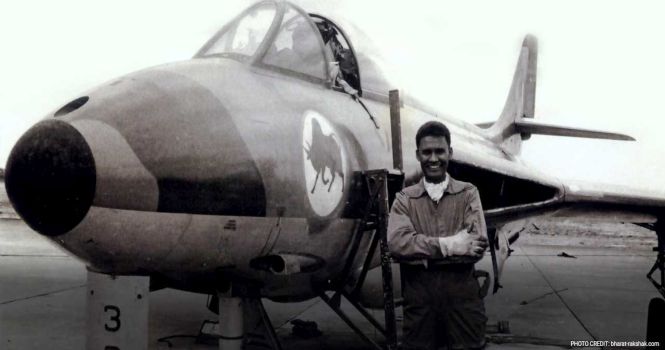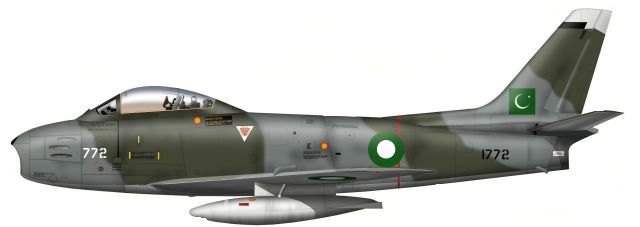Image may be NSFW.
Clik here to view.
Clik here to view.

The defence establishment is commemorating the 50th anniversary of India’s “victory” over Pakistan in the 1965 war – which proved a special time for former Indian Air Force pilot Alfred Tyrone Cooke, an Anglo-Indian from Lucknow and now settled in Australia. Five decades ago on 7 September, the then 25-year-old Flight Lieutenant shot down three Pakistani Sabres over Kaliakunda near Kharagpur and displayed exemplary courage as well as outstanding air combat skills. I was a witness to the dogfight that day, being a student in Kharagpur and that was the second attack on the IAF base by the Dhaka-specific Pakistan Air Force — and it constituted a semblance of action in an otherwise uneventful eastern theatre.
Air Marshal (Retired) Govind Chandra Singh Rajwar who was a young officer posted in Kalaikunda then has written elaborately about the air battles in the eastern theatre and he ascribes the IAF’s success on that day to two Anglo-Indian officers, one being Cooke and the other Wing Commander, Peter Maynard Wilson. He says, “There is no doubt about the skill and courage demonstrated by Cooke but I also feel that some credit needs to be given to Wilson, then OC No 16 in the Canberra Squadron, for his foresight and accurate prediction about the timing of the Sabres’ second raid. However, a brief account of what preceded the events of that day needs to put on record.
Image may be NSFW.
Clik here to view.
Clik here to view.

IAF GNATS terrorized PAF's Highly Advanced SABRE Jets and it rightfully gained the Moniker across the Globe as the "SABRE KILLER"
“In the late evening of 6 September, Air Vice-Marshal Shivdev Singh landed at Kalaikunda with the airraid plans for East Pakistan. We had just finished our dinner in the officers’ mess around 10 pm when an urgent message was received from Group Captain MB Naik, then Commander at the Air Force Station in Kalaikunda, asking all Canberra aircrew to report to the squadron briefing room immediately. There, we were briefed by Wilson regarding the bombing attacks that were to be carried out on the Chittagong airfield. It was to be a two-aircraft raid at a low level with Wilson and Squadron Leader Shankaran in the lead, followed by Squadron Leader Raghu Karve and myself in the second aircraft, after an interval of 10 minutes. Since enemy air action over Chittagong was a possibility, Wilson had briefed us that in case he encountered heavy opposition we should abandon the mission. On the other hand, if everything was normal he would just transmit ‘Press on’. We were to drop our bombs on the centre of the runway with the aim of rendering the airfield non-operational.
“The weather forecast for that day was extremely grim with quite a low cloud base and heavy monsoon rains en route (to) Chittagong. We took off from Kalaikunda in the early hours of 7 September. The torrential rain over the Bay of Bengal made conditions extremely difficult for us while flying in total darkness at a low level… As we approached the Chittagong area, the weather started clearing up and there was no enemy opposition. We prepared for the attack and dropped the bombs on the centre of the runway. On pulling up after the attack, we saw them exploding but the ones dropped by the lead Canberra were duds and failed to explode. On our return to Kalaikunda, both the Canberras were switched off across the runway in the blast pen dispersal area. We immediately proceeded in Wilson’s jeep to the COO’s office situated in the ATC building for debriefing. As soon as it commenced (at about 06.30 am), we heard some commotion with the roaring noise of low-flying aircraft overhead and ran to the open terrace to see what was happening.
“The airfield was under attack by Pakistani Sabres. While the majority of station personnel were running for shelter, Wilson stood majestically on the terrace of the ATC building and gave a running commentary on the relative positioning and attack patterns of the Sabres. He also admired their training and motivation and was remarkably composed. The Sabres had a free run with no opposition and carried out attacks in a racecourse pattern, as if it was a practice range.
“The Vampires of No 24 Squadron, lined up in the dispersal area, were glistening under the early morning sun, having been washed by overnight rain. Their camouflage nets had been removed and they were refuelled and fully-armed to undertake operational sorties in the morning after sunrise. I believe they were given Jessore airfield as their target; however, their takeoff was delayed due to potentially inclement weather. Those glittering Vampires must have been noticed by the enemy Sabres from a long distance and, after the attack, the fireworks and explosions went on for a long time. Fortunately, the Vampires were facing the runway and not the buildings. The Sabres, thereafter, went for the two Canberras that had returned from the Chittagong raid and were parked in the blast pens area. Both were destroyed.
“It was a pity that the air defence guns, though deployed on the Kalaikunda airfield, were not in a state of readiness. In fact, their barrels had been covered with canvas to protect them from the rain and/or early morning dew. It was a sad story that although the Eastern Air Command had planned and launched operational missions deep inside East Pakistan from Kalaikunda, it had taken no steps at all by way of protection against counterstrikes from the enemy. It was quite predictable and natural for the PAF to immediately follow our trail to Kalaikunda for retaliatory action after the Chittagong attack.
“I clearly remember that, after the Sabres raid was over, Wilson quickly calculated their transit times to Kurmitola in Dhaka and back, including the turnaround time for refuelling and rearming, and predicted that the second raid would be around 10.30 am. He told Wing Commander Dicky Law that it must be quite tempting for them to attack Kalaikunda again since they had seen so many aircraft assets at the station without any opposition. Therefore, he told us to be fully prepared to deal with them effectively when they arrived for the second raid. Wilson’s prediction of the timing of the second raid was extremely accurate. This second attack on Kalaikunda was such a disaster for the PAF Sabres that they never ventured to attack Kalaikunda again for the remainder of the 1965 war.
“When the body of Afzal Khan, the pilot of the Sabre shot down by Cooke, was recovered, I believe he was wearing civilian clothes under his flying overalls and had a large amount of Indian currency with him. In case he had successfully ejected, he would have easily mingled with locals and, possibly, never have been captured.”
While watching that dogfight over the IIT-Kharagpur campus, I remember how the Pakistan Sabre hit a mud hut in a village on the outskirts of Kalaikunda and killed a woman and a young boy. It disintegrated into pieces and I saw the beheaded body of the Pakistani pilot. The debris was scattered all over and I still recall a large aluminum piece of the aircraft I’d brought home as a souvenir.
Both Cooke and Wilson were rewarded with Vir Chakras and later Air Commodore Wilson was awarded the Param Vishistha Sewa Medal for serving in the 1971 Indo-Pakistani war.
Cooke, who migrated to Australia after his retirement from the IAF, visited India earlier this month and dedicated the Vir Chakra he received to the Bulls, the No. 14 Squadron he’d represented. He said at the ceremony, “I am overwhelmed to be here. Thank you for giving me this honour. I was just doing my job, defending my area and shooting down as many enemy fighters as I could. I was lucky to have survived. My Vir Chakra belongs to the squadron.”
Commodore commandant of the squadron at Ambala, Air Vice-Marshal Sunil J Nanodkar and Wing Commander Devashish Kukreti, who is Commanding Officer, accepted the medal from Cooke.
